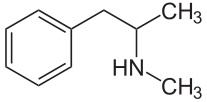Aimar Lorenzo
Di Franco Luca
In this item we try to elucidate the mechanisms involved in methamphetamine-induced neurotoxicity, in particular in dopaminergic neurons.
Methamphetamine

Methamphetamine (N-methyl-alpha-methylphenethylamine) is a neurotoxin and potent psychostimulant of the amphetamine classes that is used to treat attention deficit hyperactivity disorder (ADHD) and obesity.
In low doses, methamphetamine can cause an elevated mood and increase alertness, concentration, and energy in fatigued individuals.
At higher doses, it can induce psychosis, rhabdomyolysis and cerebral hemorrhage.
Methamphetamine is known to have a high potential for abuse and addiction.
Unlike amphetamine and cocaine, methamphetamine is neurotoxic to humans, damaging both dopamine and serotonin neurons in the CNS. Entirely opposite to the long-term use of amphetamine, there is evidence that methamphetamine causes brain damage from long-term use in humans; this damage includes adverse changes in brain structure and function, such as reductions in gray matter volume in several brain regions and adverse changes in markers of metabolic integrity.
Beyond neurotoxicity, magnetic resonance imaging studies on human methamphetamine addicts and abusers indicate adverse neuroplastic changes, such as significant abnormalities in various brain structures.
1- Ovedose
A methamphetamine overdose may result in a wide range of symptoms. A moderate overdose of methamphetamine may induce symptoms such as: abnormal heart rhythm, confusion, high or low blood pressure, hyperthermia, myalgia, severe agitation, tachypnea, tremor.
An extremely large overdose may produce symptoms such as adrenergic storm, methamphetamine psychosis, cardiogenic shock, cerebral hemorrhage, circulatory collapse, renal failure.
Death from fatal methamphetamine poisoning is typically preceded by convulsions and coma.
2- Mechanism of interaction
It is important to elucidate the mechanisms involved in methamphetamine-induced neurotoxicity. Dopamine receptors may be a plausible target to prevent this neurotoxicity. Genetic inactivation of dopamine D1 or D2 receptors protects against the loss of dopaminergic fibres in the striatum and loss of dopaminergic neurons in the substantia nigra.

When a person takes meth (metanphetamine), a chain of events occurs at the dopamine synapses.
When meth stimulates these transmitters to excessively release dopamine into many different areas of the brain, the safety mechanism would normally react by reabsorbing and transporting the excess chemicals back into the synaptic vessels, but meth blocks dopamine re-uptake, and a gradual chemical buildup occurs.
This chemical buildup has many different effects on a person's behavior. For the meth user the chemical buildup resembles a dangerous rollercoaster ride. As dopamine levels rise in the brain, so do the feelings of euphoria. This initial buildup is like the start of the rollercoaster. When the drug finally wears off, and the dopamine levels gradually decrease, the meth user plunges to the bottom of this ride losing all the feelings of euphoria and wellbeing. These euphoric feelings will not return until the dopamine system is once again stimulated.
2.1 Role of Dopamine

Dopamine (DA) is the neurotransmitter that plays a part in controlling movement, thought processes, emotions, and the pleasure centers of the brain. When a person physically works out or accomplishes a difficult task, the brain releases excess dopamine into certain areas of the brain. Any release of dopamine induces a sense of euphoria and wellbeing.
Clinical reports suggest that methamphetamine abusers are predisposed to Parkinson’s disease.
3- Parkinson's disease
Parkinson's disease (PD) is a neurodegenerative disorder predominantly affecting the elderly. The aetiology of the disease is not known, but age and environmental factors play an important role. The molecular basis of Parkinson's disease is the loss of dopamine in the basal ganglia (caudate/putamen) due to the degeneration of dopaminergic neurons in the substantia nigra, which leads to the motor impairment characteristic of the disease.
Methamphetamine exposure damages dopaminergic neurons in the substantia nigra, resulting in a significant loss of dopamine in the striatum. Biochemical and neuroimaging studies in human methamphetamine users have shown decreased levels of dopamine and dopamine transporter as well as prominent microglial activation in the striatum and other areas of the brain, changes similar to those observed in PD patients.

FONTI:
http://en.wikipedia.org/wiki/Methamphetamine
http://www.ncbi.nlm.nih.gov/pmc/articles/PMC2831101/
http://www.ninds.nih.gov/disorders/parkinsons_disease/parkinsons_disease.htm
http://www.ncbi.nlm.nih.gov/pubmed/23600399
http://en.wikipedia.org/wiki/Dopamine